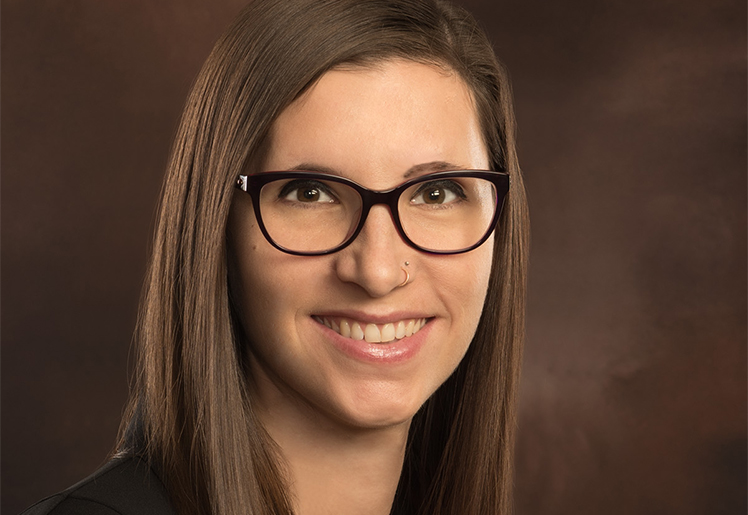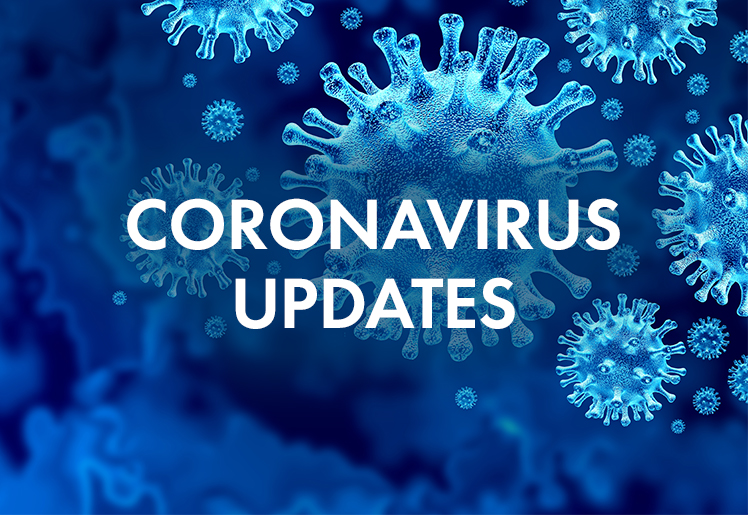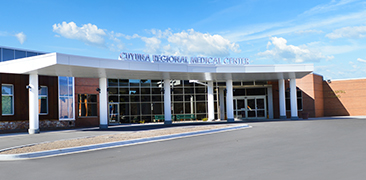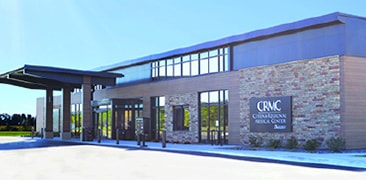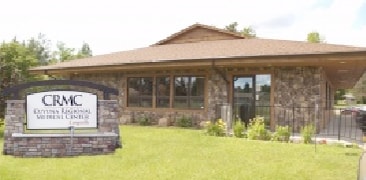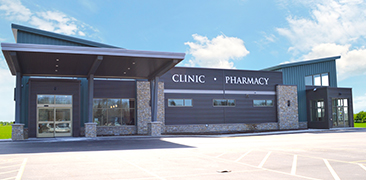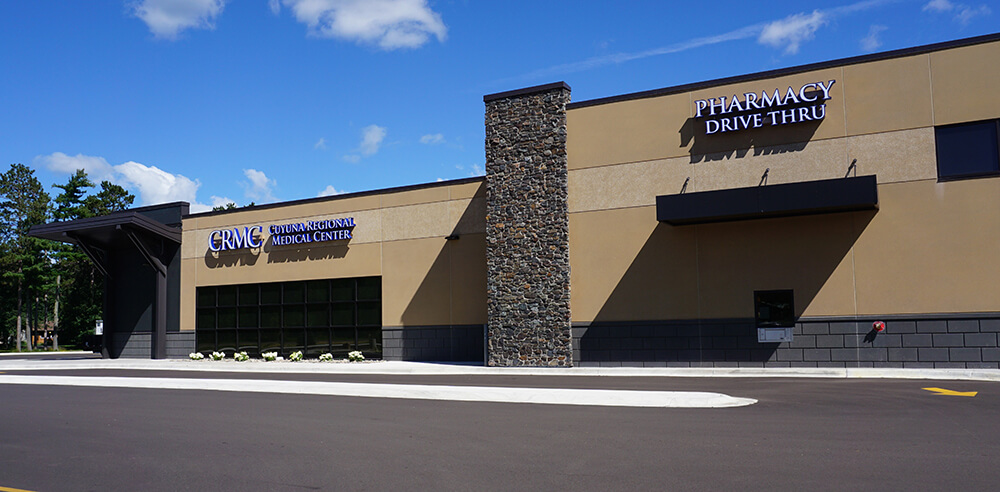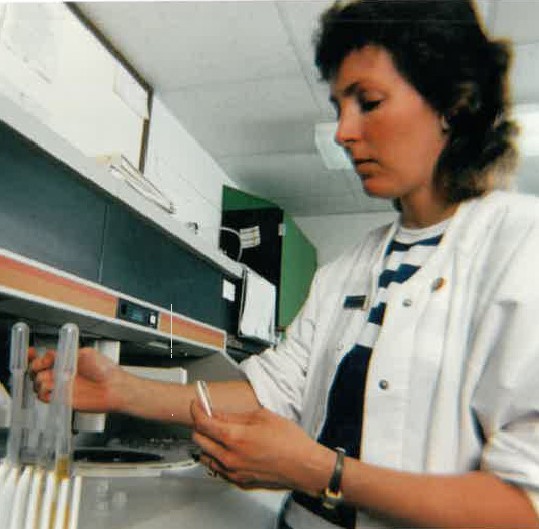
On June 30, Mary McMillan of Ironton plans to leave Cuyuna Regional Medical Center where she has been managing and developing the Laboratory for 41 years to ensure doctors get vital results when they are needed.
The Medical Laboratory Scientist began working at CRMC as a bench tech in 1982 and has seen expansive growth of CRMC over the last four decades, as well as substantial changes in Lab tests, protocols, and equipment.
“When I started, all tests were manual, nobody wore gloves, and everything was reusable, people even smoked cigarettes in the hospital. Automation consistently grew to where we are now--It has been quite an advancement.”
With all the Lab’s multiple, complex analyzers and microscopes humming in the background just outside her office, Mary recalled that there were five employees completing about 500 tests weekly when she began her career. Today, there are 35 lab employees who keep accurate testing and documentation going 24 hours a day, seven days a week on about 5,000 tests. When she started, a metabolic profile took four hours to complete; now it is done in 12 minutes.
“We took call, everything was manual, there were no computers or fax machines. We were always such a good, cohesive team. There were no phlebotomists, so we had to do everything--draw blood and examine and analyze blood, bodily fluids, tissues, and cells. We worked hard to get the morning run done before doctors made morning rounds.”
Mary said when she started working at CRMC, there was only one surgeon and four providers who provided all services including delivering babies. Those numbers compare to the 15 surgeons, 45 other physicians, and 38 advanced practice providers working at CRMC today. An intellectually curious person, she is amazed at how very specialized medicine has become but feels it is the best way to provide patient care. She has also found it interesting to work with various specialists throughout the years and determine their lab needs.
Of course another major change came in record keeping. For years, everything was recorded on paper. Orders were given to the Lab by the ward secretary on a four-part carbon document on which results were tallied. “You had to press hard to get through all four copies and we had to run the results to the ER and ICU. The Lab kept one part and the others were for the patient chart, provider, and billing. Now all orders and test results are secured electronically.”
Today everything in the department is computerized and Lab results automatically flow from the analyzer to a patient’s chart. When blood is drawn, the phlebotomist uploads information to the correct analyzer and with MyChart, sometimes patients see results before their provider.
However, when there are unusual blood cells, staff must still look at the test manually. “There is no replacement for my brilliant team, they are the quality control program, trouble shoot, problem solve, and serve as a liaison to providers. Staff review every result, explain why results are different, and look at variances. If a result does not make sense, they take a deeper dive.”
It was 1990 when the detail-oriented tech became the Lab Director. She managed the department about half time and continued to work as a bench tech the other half but found it difficult to be a peer and the manager.
Year after year, more providers joined the organization, and the Lab became busier and busier. Staff were on call 24/7, which Mary says was brutal. By 1998, Mary could no longer do bench work because there was so much to manage. She hired their first phlebotomist, and the department became fully staffed. Now there are 10 phlebotomists and patient access specialists working in the Lab which she says are essential.
The physical location of the Lab also changed. The first Lab Mary worked in had an outside wall, with windows, which was nice. In 2011, the Hospital and Clinic Labs merged and moved to where the ER used to be. In 2016, the Lab expanded into its current location adjacent to the ER.
In the lab, Mary dealt with many challenges and numerous changes, but she feels strongly that she and her “family” of workers always dealt well with them.
Two of the biggest challenges she—and the entire hospital—faced during her time at CRMC were the emergence of HIV and several years later, COVID. “HIV coming to the forefront prompted much more personal protection than we had used before. COVID increased that practice.”
The COVID-19 pandemic also added to the testing volume and strained Lab staff with the constant evolution of new needs. “Nothing can compare with COVID. I cannot think of anything over the years, as an outbreak, that has been more challenging . . . the technologists here really stepped up and worked beyond their respective duties.”
Mary also experienced her own personal health challenge. In 2010, she was diagnosed with breast cancer following a routine mammogram. She was treated immediately and has been cancer free since.
Now her biggest challenge is staffing. Mary hopes new students will consider studying clinical laboratory science because there is a huge demand for scientists. CRMC currently has numerous openings which she has tried to fill for some time. Mary says the last 10 years have been especially challenging with an average of five travelers needed. She is excited, however, for a new program launched to recruit international staff and grateful for the dual pipeline grant which assists staff in becoming Medical Lab Technician certified as well as the organization’s tuition reimbursement program.
Over the years, Mary, who has a genuine concern for others, had the opportunity to mentor and train others going into the profession. The director says It has been exciting to watch staff grow and rewarding to see employees come up in the ranks. She is proud of the phlebotomists and patient access specialists who have become medical lab assistants, lab techs, lead techs, and even a manager. She is also grateful for the career laddering opportunities which she says in good for patient care and an employee satisfier.
“I’ve always appreciated how administration trusted me to manage the department to increase efficiency and promote productivity and enjoyed that they trusted me to find best equipment.”
A life-long learner, Mary sharpened her analytical and critical thinking skills by annually completing continuing education courses. A graduate of Michigan Technology University in Houghton, she earned a Bachelor of Science degree in medical technology with honors. Originally from Escanaba, Mich., with a keen interest in scientific work, Mary first studied nursing but quickly realized it was not her thing. A friend who was studying to become a medical tech told her she did well with her labs and suggested she try medical technology. The conscientious young woman took a class, and it has been an excellent fit ever since.
Following an internship at St. Luke’s Hospital in Duluth, Mary became a phlebotomist at Jackson County Public Hospital in Iowa. Then she went to work at Kenosha Memorial Hospital in Wisconsin for two years. Because she felt a calling back to northern Minnesota, she applied for the position at Cuyuna Range District Hospital, now named CRMC.
For Mary, the time she spent at CRMC has put her in contact with a lot of people she respects and will remember. “It is a true blessing for me. I am quite proud to have worked with so many inspiring people over the years.”
Mary was passionate about her work at CRMC, but what she liked best was the family atmosphere. “My life has been intricately woven with milestones of my personal life intertwined with a twenty-four-seven responsibility for the Lab.” She discussed losses and joys that she and her lab “family” had experienced including weddings, divorces, funerals, and grandchildren.
“We are so grateful to Mary for her dedication and steadfast servant leadership,” said Lynn Severson, Chief Operating Officer. “Her contributions have been critical to our success and greatly appreciated by all. She is leaving a legacy of strong leadership behind and will always be a part of our CRMC family.”
Her colleagues at the lab are not looking forward to her last day, either.
"I will really miss working with her - the years of experience and guidance she has shared with me will be priceless in navigating my new role,” said Lab Manager Jennie Peterson. “She will be missed by all of us more than she will ever know."
With her retirement, Mary takes multiple memories from her years at CRMC. She will always cherish them. Now she and her husband John are ready to build more.
Self-identified as Type 3 because she cares for her husband who has diabetes, she hopes to someday write a book about what to expect when caring for a loved one with diabetes. She is elated that he was recently approved for a pancreas transplant which she says will significantly improve his quality of life.
While Mary is looking forward to enjoying more time reconnecting with her family, traveling across the country, and getting back to some hobbies she enjoys such as reading and following bird migrations, she said she will miss the day-to-day challenges of managing the Lab.
“A good challenge is what has kept me here all these years. I’m a problem-solver. I will miss the challenges and the people I work with, but it’s time.”
